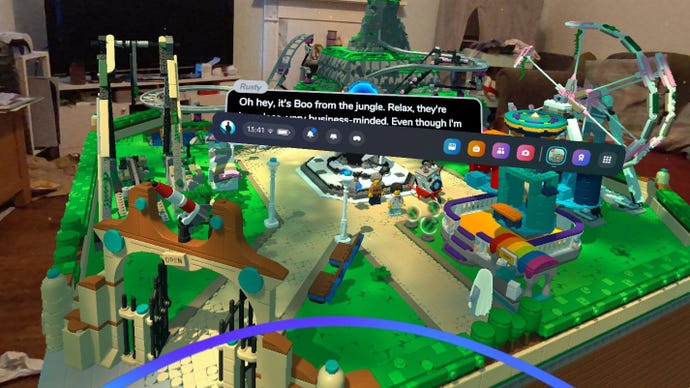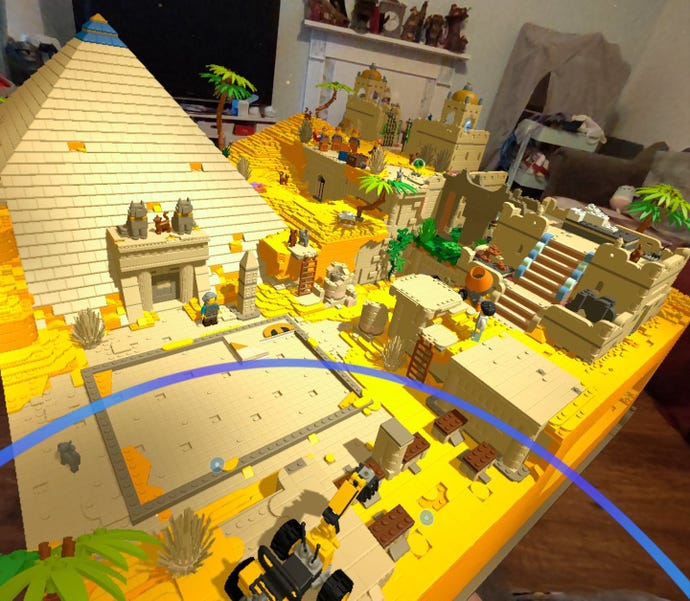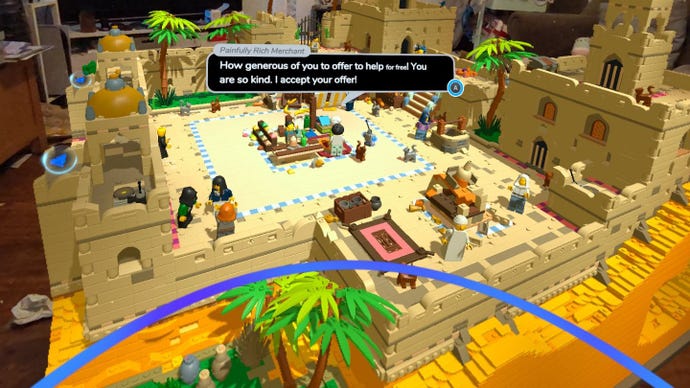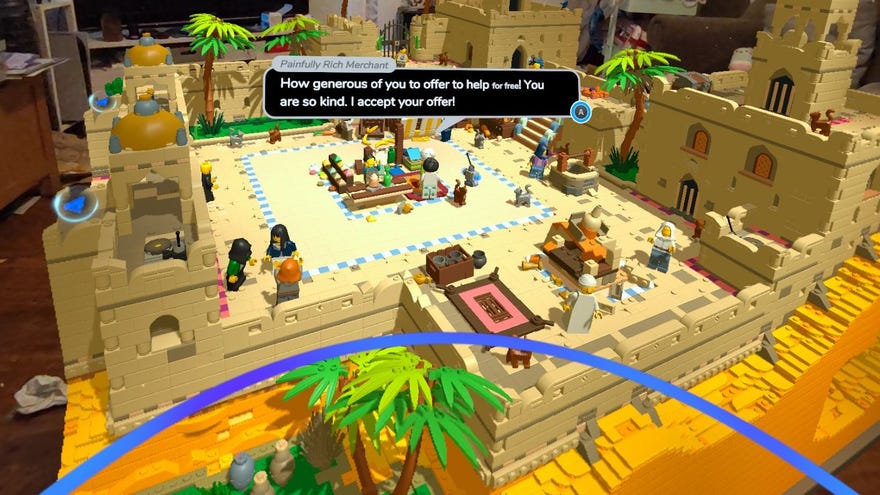Reality Bytes: Lego Bricktales offers a glimpse of the future. But it could be even better
Blockbuster
VR is at its best when it makes you feel like you're living in the actual future. Given how everything new and exciting ultimately becomes normal and mundane, this is perhaps an unfair expectation of technology that is now a decade old. Nonetheless, if you want me to sit with a shoebox pressed uncomfortably against my eyes for two hours like an ocular gom jabbar, then what's inside the shoebox better be pretty darned transformative.
Which is to say that LEGO Bricktales provided one of those moments. I was sat in my living room, with all its clutter visible through the Quest 3's coloured passthrough, and hovering above my table was a great big LEGO diorama of a jungle. All of it was rendered perfectly to scale, as if I could pick up the minifigs between my thumb and forefinger. Yet all of it was moving of its own accord, as if I'd somehow stumbled into a child's dream.
Crash. In barrels the future, smashing through the temporal wall like the Kool-Aid Guy. You can play with LEGO that moves now. Oh yeah!

As is always the case with reality, virtual or otherwise, there are caveats. For all it does well, LEGO Bricktales is not the killer app for Mixed Reality it could be. Moreover, the price you pay for LEGO that moves is that you can no longer feel its studs and edges between your fingers. But even as someone who is at best a LEGO fan by proxy, I can't help but find Bricktales a little bit magical.
If you're sat there thinking "Wait, isn't LEGO Bricktales a regular, flatscreen game?" Don't worry, your brain is working properly. Bricktales originally launched for PC and consoles about a year ago, but developer ClockStone Software has since ported it to Quest 2, 3, and Pro, adding touch controls and other VR features. The premise sees you, playing as a custom LEGO figurine of your choice, trying to help your nutty professor grandad rebuild his amusement park, which you do by teleporting to alternate dimensions to collect "Happiness Cubes".
If you just laughed and/or gagged at the phrase "Happiness Cubes", don't worry, the game's writing is better than this summary makes it seem. It's light on plot, heavy on jokes, and while a slight lack of precision stops many gags from being hi-larious, most of them elicited a daft grin or a light chuckle from me. In short, not as good as the LEGO Movie, but better than the LEGO Batman Movie.
The point is you're going to be visiting numerous LEGO worlds, which in VR resemble larger versions of the rotating cube levels seen in the Nintendo Switch game Captain Toad: Treasure Tracker. These, incidentally, are marvellous, big, shiny, hefty-looking LEGO that would cost £thousands in real-life, only with water than glistens, animated characters, and cute collectible animals like chameleons and LEGO-dot ladybirds that wiggle around in an alarmingly winning manner. You can also grab the edges of each level with your tourch controllers and move it around in your hands, viewing it from different angles, and lifting it to eye level so you can peer through its caves and tunnels.

As for what you do in these levels, well, it's varying degrees of tactile puzzle-solving. Your LEGO avatar in the game world is controlled separately using the left thumbstick, much like the mouse in the similarly adorable VR game Moss. But it won't be long before your character finds their path blocked by a cliff or a gorge. At this point, the game will switch to a whitebox view, and ask you to build a bridge or a stairway out of designated LEGO blocks.
These building puzzles are more challenging than I expected, although I wouldn't go so far as to call them difficult. To start with, Bricktales features a basic physics simulation, so you need to ensure that each build is structurally sound. Your bridge or stairway must be connected to the starting anchor point, and support the weight of your character at all connections. In addition, each puzzle furnishes you with a combination of bricks that tend toward the eclectic. Rare is it you'll get more than a couple of 4x2 blocks, and you'll often be building with a handful of plastic shrapnel that requires careful, considered assembly.
Aside from the unavoidable lack of tactility, Bricktales' building system is intuitive and satisfying. It is a slight shame that it pulls you out of its colourful worlds for each building activity. Building something separately and then seeing it appear in the game world isn't as fun as gradually assembling it in situ, even if it makes the actual construction process easier.
Outside of the building challenges, your character acquires numerous abilities that let them navigate other obstacles in the world. There are five of these in total, including a stomp ability that breaks objects like pots and small plants, and an X-ray vision mode that highlights invisible objects on the world (and briefly turns your LEGO avatar into a LEGO skeleton, one of the game's better visual gags). Some paths will push you further along the story, while others lead to optional rewards like currency-filled treasure chests, which you can use to buy new outfits for your blocky self. Not all these paths are accessible immediately, meaning you'll return to previous worlds often if you want to explore everything.


I've no major complaints about what LEGO Bricktales does. The story is a heap of nonsense, but in a way that's mostly fun, and I'd prefer the building puzzles to be embedded in the world itself. There are, however, a couple of things Bricktales doesn't do that feel like missed opportunities. The first is a dedicated sandbox mode which lets you build whatever you want. You can play around with individual puzzle sets once you've completed them, but that's still limiting compared to what Bricktales could let you do.
In addition, while Bricktales uses the Quest 3's mixed reality features to project its giant puzzle cubes into your living space, it isn't really a mixed reality game. You can orient the dioramas so it looks like you're playing LEGO on your table, but the game doesn't let you interact with your table, playing with virtual LEGO toys in your own space. In fairness to ClockStone, Bricktales wasn't designed specifically for Quest 3. Heck, it wasn't designed for VR at all initially, which makes it quality as a VR game all the more impressive. But such a feature would not only justify the Quest 3's MR features, it would also make Bricktales an absolute must have.
As it stands, Bricktales is merely an excellent VR game, rather than an essential one. But I've thoroughly enjoyed my time with it, a gentle, funny VR puzzler that's a little chewier than I expected, but not too much. And those first few minutes with it, looking down at a LEGO set come to life, were wondrous in a way I'm unlikely to forget anytime soon. Be careful giving it to your children, because their heads might just explode.









